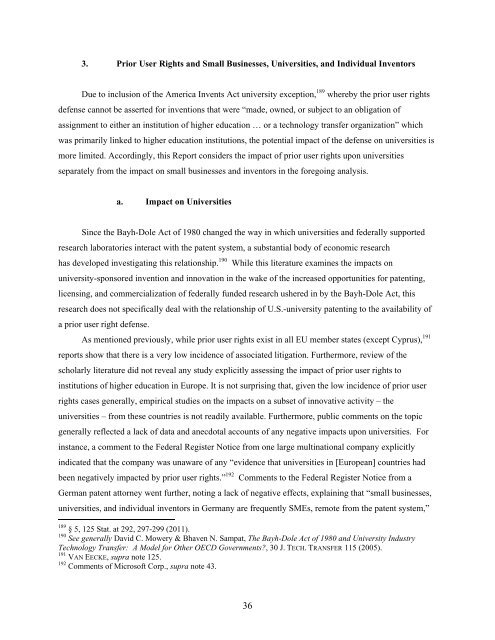Prior User Rights Study Report to Congress - America Invents Act
Prior User Rights Study Report to Congress - America Invents Act
Prior User Rights Study Report to Congress - America Invents Act
You also want an ePaper? Increase the reach of your titles
YUMPU automatically turns print PDFs into web optimized ePapers that Google loves.
3. <strong>Prior</strong> <strong>User</strong> <strong>Rights</strong> and Small Businesses, Universities, and Individual Inven<strong>to</strong>rsDue <strong>to</strong> inclusion of the <strong>America</strong> <strong>Invents</strong> <strong>Act</strong> university exception, 189 whereby the prior user rightsdefense cannot be asserted for inventions that were “made, owned, or subject <strong>to</strong> an obligation ofassignment <strong>to</strong> either an institution of higher education … or a technology transfer organization” whichwas primarily linked <strong>to</strong> higher education institutions, the potential impact of the defense on universities ismore limited. Accordingly, this <strong>Report</strong> considers the impact of prior user rights upon universitiesseparately from the impact on small businesses and inven<strong>to</strong>rs in the foregoing analysis.a. Impact on UniversitiesSince the Bayh-Dole <strong>Act</strong> of 1980 changed the way in which universities and federally supportedresearch labora<strong>to</strong>ries interact with the patent system, a substantial body of economic researchhas developed investigating this relationship. 190 While this literature examines the impacts onuniversity-sponsored invention and innovation in the wake of the increased opportunities for patenting,licensing, and commercialization of federally funded research ushered in by the Bayh-Dole <strong>Act</strong>, thisresearch does not specifically deal with the relationship of U.S.-university patenting <strong>to</strong> the availability ofa prior user right defense.As mentioned previously, while prior user rights exist in all EU member states (except Cyprus), 191reports show that there is a very low incidence of associated litigation. Furthermore, review of thescholarly literature did not reveal any study explicitly assessing the impact of prior user rights <strong>to</strong>institutions of higher education in Europe. It is not surprising that, given the low incidence of prior userrights cases generally, empirical studies on the impacts on a subset of innovative activity – theuniversities – from these countries is not readily available. Furthermore, public comments on the <strong>to</strong>picgenerally reflected a lack of data and anecdotal accounts of any negative impacts upon universities. Forinstance, a comment <strong>to</strong> the Federal Register Notice from one large multinational company explicitlyindicated that the company was unaware of any “evidence that universities in [European] countries hadbeen negatively impacted by prior user rights.” 192 Comments <strong>to</strong> the Federal Register Notice from aGerman patent at<strong>to</strong>rney went further, noting a lack of negative effects, explaining that “small businesses,universities, and individual inven<strong>to</strong>rs in Germany are frequently SMEs, remote from the patent system,”189 § 5, 125 Stat. at 292, 297-299 (2011).190 See generally David C. Mowery & Bhaven N. Sampat, The Bayh-Dole <strong>Act</strong> of 1980 and University IndustryTechnology Transfer: A Model for Other OECD Governments?, 30 J. TECH. TRANSFER 115 (2005).191 VAN EECKE, supra note 125.192 Comments of Microsoft Corp., supra note 43.36


